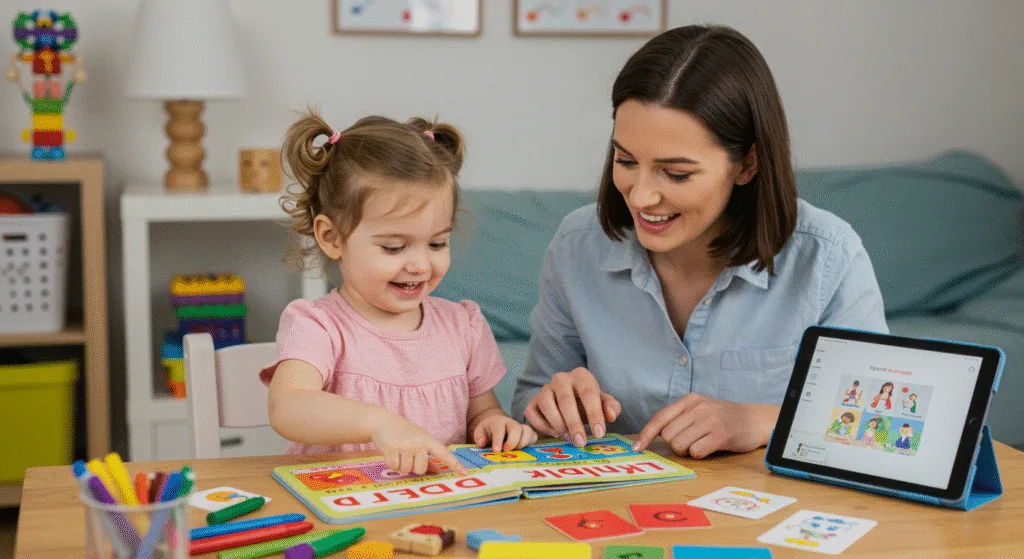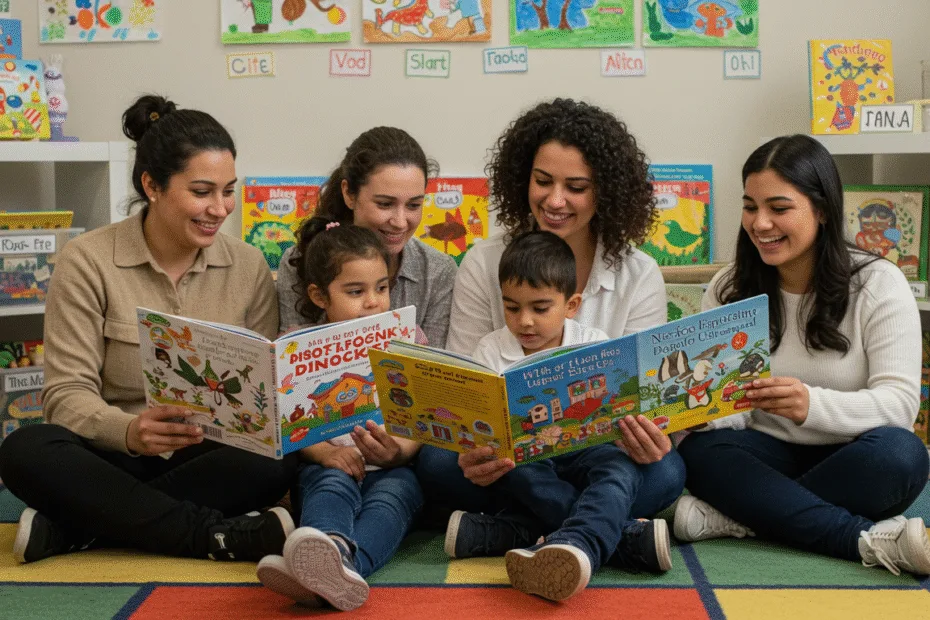Support early literacy in multilingual homes with proven strategies. Foster bilingual reading skills, language development, and cognitive growth from an early age.
Introduction: The Importance of Early Literacy in Multilingual Homes
In today’s globalized world, many families are raising children in multilingual environments. Whether due to immigration, intermarriage, or exposure to multiple languages through media and travel, the number of multilingual households is growing rapidly. Supporting early literacy in multilingual homes is essential not only for academic success but also for preserving cultural identity and enhancing cognitive development.
Children who grow up exposed to more than one language often develop strong communication skills, better problem-solving abilities, and a heightened sense of empathy. However, fostering literacy development in such settings can be challenging if parents are unsure how to navigate the process effectively.
This article explores the unique opportunities and challenges associated with raising bilingual readers, offers practical tips for parents, and discusses how early literacy can be nurtured in a multilingual context.
Understanding Early Literacy in Multilingual Contexts
What Is Early Literacy?
Early literacy refers to the foundational skills that children develop before they learn to read and write. These include:
- Vocabulary building
- Phonological awareness (ability to hear and manipulate sounds)
- Narrative comprehension
- Print awareness (understanding that written symbols represent spoken words)
For monolingual children, these skills are typically developed in one language. However, in multilingual homes, these skills may be cultivated across two or more languages simultaneously.
How Does Multilingualism Affect Literacy Development?
Research consistently shows that being raised in a multilingual environment does not hinder literacy development. In fact, it can offer significant cognitive benefits. Bilingual children often demonstrate enhanced executive functioning skills, including better attention control, mental flexibility, and working memory.
However, there are nuances to consider:
- Language Separation vs. Code-Switching: Some children learn to separate their languages by context (e.g., English at school, Spanish at home), while others mix them freely.
- Vocabulary Size per Language: While bilingual children may have smaller vocabularies in each language compared to monolingual peers, their total vocabulary across both languages is often equal or larger.
- Phonological Awareness Across Languages: Skills like rhyming or identifying letter sounds may transfer between languages, especially if the languages share similar structures or scripts.
Understanding these dynamics helps parents and educators create effective early literacy strategies tailored to multilingual environments.
Benefits of Promoting Early Literacy in Multilingual Homes
1. Cognitive Advantages
Bilingual children often outperform monolingual peers in tasks requiring attention, inhibition, and switching between tasks. These cognitive benefits are linked to early exposure to and practice with multiple languages.
2. Cultural Connection and Identity Formation
Language is deeply tied to culture and identity. By supporting early literacy in the home language, parents help preserve family heritage and strengthen emotional bonds.
3. Stronger Academic Outcomes
Children who develop strong early literacy skills in any language tend to perform better academically overall. When these skills are built in a multilingual context, students are more likely to become biliterate—fluent in reading and writing in both languages.
4. Enhanced Communication Skills
Exposure to multiple languages from an early age fosters greater sensitivity to language structure, tone, and meaning. This leads to better verbal and nonverbal communication skills.
Common Myths About Multilingual Literacy
Despite the overwhelming evidence supporting multilingual literacy, several misconceptions persist:
Myth 1: Learning Two Languages Causes Language Delay
Fact: There is no scientific evidence that bilingualism causes speech or language delays. Delays may occur due to other developmental issues, but not because of learning two languages.
Myth 2: Children Should Only Learn One Language Until They’re Fluent
Fact: Simultaneous language learning is natural and beneficial. Children can distinguish between languages even as infants.
Myth 3: Home Language Interferes with School Language Success
Fact: A strong foundation in the home language actually supports learning the majority school language. Concepts learned in one language transfer to another.

Strategies to Support Early Literacy in Multilingual Homes
1. Read Aloud Daily in All Languages Spoken at Home
Reading aloud is one of the most powerful tools for developing early literacy. It exposes children to new vocabulary, sentence structures, and storytelling techniques.
Tips for Parents:
- Choose books that reflect your child’s interests and cultural background.
- Use expressive voices and gestures to make stories engaging.
- Ask open-ended questions about the story to build comprehension.
2. Create a Language-Rich Environment
Surround your child with print materials in all languages used at home. Label household items, display posters with letters and numbers, and keep a variety of books accessible.
3. Incorporate Songs, Rhymes, and Fingerplays
Music and rhythm enhance phonological awareness and memory. Sing lullabies, nursery rhymes, and folk songs in different languages to reinforce sound patterns.
4. Encourage Conversations in All Languages
Talk frequently with your child using complete sentences. Discuss daily events, ask “why” and “how” questions, and encourage storytelling.
5. Use Technology Thoughtfully
Educational apps and videos in the home language can support literacy development. Look for interactive content that encourages participation rather than passive watching.
6. Connect with Community Resources
Libraries, cultural centers, and online platforms often offer bilingual storytimes, book exchanges, and language classes for young children.
Choosing the Right Books for Multilingual Learners
Selecting appropriate reading material is crucial for early literacy success. Here are some guidelines:
Age-Appropriate Content
Choose books that match your child’s developmental stage. Board books with bright pictures work well for toddlers, while picture books with simple text suit preschoolers.
Culturally Relevant Stories
Books that reflect your family’s heritage and values help children feel seen and understood. Look for multicultural authors and illustrators.
Dual-Language and Translated Books
These allow children to compare languages side-by-side, promoting cross-linguistic awareness. Many publishers now offer high-quality bilingual editions.
Interactive and Engaging Formats
Pop-up books, lift-the-flap books, and touch-and-feel books make reading fun and memorable.
Supporting Emergent Writing in Multilingual Homes
Writing skills begin to develop long before children hold a pencil. In multilingual homes, encouraging emergent writing can take various forms:
- Scribbling and drawing
- Writing their name in different languages
- Dictating stories for adults to write down
- Using invented spelling in both languages
Parents should celebrate all attempts at writing, regardless of accuracy, to build confidence and motivation.
Role of Educators in Supporting Multilingual Literacy
While parents play a vital role, educators also contribute significantly to early literacy outcomes in multilingual homes.
Key Responsibilities of Teachers:
- Recognize and value home languages as assets
- Provide culturally responsive instruction
- Assess language and literacy skills fairly across languages
- Collaborate with families to support home language use
Schools that embrace multilingualism foster inclusive learning environments where all students thrive.
Addressing Challenges in Multilingual Literacy Development
Despite its many benefits, supporting early literacy in multilingual homes can present challenges. Here are common obstacles and solutions:
Challenge 1: Limited Access to Books in the Home Language
Solution: Seek out community libraries, online retailers, or international book fairs. Digital platforms like StoryWeaver and International Children’s Digital Library offer free multilingual books.
Challenge 2: Parental Uncertainty About Language Strategies
Solution: Attend workshops, join parenting groups, or consult with bilingual educators. Knowledge-sharing builds confidence.
Challenge 3: Societal Pressure to Speak Only the Majority Language
Solution: Advocate for language equity in schools and communities. Emphasize the importance of maintaining the home language.
Challenge 4: Balancing Multiple Languages Without Overwhelm
Solution: Establish consistent routines. For example, designate specific times or contexts for each language (e.g., morning = English, evening = Mandarin).
The Long-Term Impact of Early Literacy in Multilingual Homes
Investing in early literacy in multilingual homes yields lifelong rewards:
- Higher Academic Achievement: Strong early literacy skills predict later success in reading, writing, and critical thinking.
- Greater Career Opportunities: Proficiency in multiple languages opens doors in the global job market.
- Stronger Family Bonds: Shared language and stories strengthen intergenerational connections.
- Increased Cultural Competence: Multilingual individuals are often more empathetic and globally aware.
Conclusion: Building a Brighter Future Through Multilingual Literacy
Early literacy in multilingual homes is not just about teaching children to read—it’s about empowering them to thrive in a diverse, interconnected world. With intentional support, children can become confident, biliterate learners who value their linguistic heritage and embrace the richness of multiple cultures.
Parents, educators, and policymakers all have a role to play in creating environments where multilingual children are celebrated, supported, and given the tools to succeed.
By prioritizing early literacy in multilingual homes, we invest in the next generation of thinkers, communicators, and global citizens.
Frequently Asked Questions (FAQs)
Q1: Can speaking two languages confuse a child?
No, research shows that children can easily distinguish between languages from an early age. Confusion is rare and usually temporary.
Q2: Should I speak only one language at home if my child has a speech delay?
No. Language delay is not caused by bilingualism. Supporting both languages can actually provide more communication tools for the child.
Q3: How do I know if my child is developing literacy equally in both languages?
Monitor progress in both languages separately. If concerns arise, consult a bilingual speech-language pathologist.
Q4: What if my child prefers one language over the other?
It’s normal for children to go through phases of preferring one language. Continue modeling both and provide positive reinforcement for using the less-preferred language.
Q5: Where can I find bilingual books for young children?
Check local libraries, online retailers like Amazon or Barnes & Noble, or digital platforms like Epic! and StoryWeaver for free multilingual titles.
Final Thoughts
Promoting early literacy in multilingual homes requires intentionality, patience, and celebration of linguistic diversity. With the right tools and mindset, every family can nurture bilingual readers who are confident, curious, and connected to their roots.
Read This Article: Homeschooling Without Internet ! A Complete Guide


